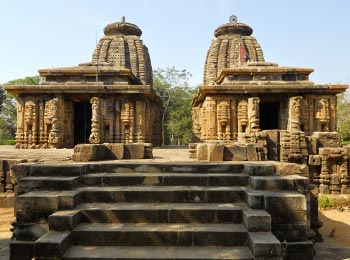- Shiva
Chari Sambhu Temple / Gandharadi Temple
- Jagati,Odisha
- View on map
- Tell us about this temple
Overview
Chari Sambhu Temple or Gandharadi Temple is located at the bank of river Mahanadi in Gandharadi village (Janhapank area) of Boudh district. It is famous for twin temples of Nilamadhava and Sidheswar. These temples display high quality architectural work. These temples attracts visitor throughout the year.
About the Temple
Jagati is arranged at a separation of 16 km. from Boudh. Close to the town at Gandhradi, is arranged the well known twin temples of Nilamadhava and Sidheswar. These temples were developed under the support of the Bhanja leaders of Khinjali mandala in ninth century AD. These two temples were based on one stage. The temple on the left is devoted to Siva and is called Siddheswar. The temple's sikhara is surmounted by a Sivalinga. The second temple is committed to Vishnu and is called Nilamadhava and its sikhara is surmounted by a wheel of blue chlorite. Every side had four mainstays of which the focal ones flanked an opening. Initially these two Jagamohanas seem to have been open on all sides; yet later on the lintels on all sides seem to have given away and afterward it got to be distinctly important to fill in the crevices between columns except for the four openings. The style of ornamentation in the jagamohans of the Gandharadi temples is by and large unique. Indeed, even adapted chaitya-windows are once in a while to be seen at Gandharadi with the exception of at the bases of the pilasters of the vimana. The ornamentation on these two jagamohans is exceptionally straightforward and considerably less packed. The significance of the Gandharadi temples lies in the way that they give a connection and that a critical one, in the chain of the development, in the chain of the advancement of the medieval Orissa temple sort.
Legend and Stories
The early history of Boudh is still in indefinite quality. Notwithstanding, the disclosure of striking Buddhist statues from Boudh drove a few researchers to trust that Boudh was a vital Buddhist focal point of Orissa. From the epigraphic records it is realized that amidst eighth century AD, Boudh locale was under the control of the Bhanja rulers and was a piece of Khinjali Mandala. The most punctual known leader of this Bhanja family was Nettabhanja who was governing over the Dhenkanal district as autonomous ruler, however his successor moved towards Boudh-Sonepur locale and built up Khinjali Mandala and controlled there as the feudatory of the Bhauma Karas of Tosali.
The Sonepur Copper Plate of Satrubhanja Dev, child of Silabhanja notices the name Khinjali Mandala interestingly and on this premise it is trusted that Silabhanja Dev was the organizer of Bhanja Kula of Khinjali Mandala. Their capital was Dhirtipura, which has been related to Boudh town. Satrubhanja Dev – II, a leader of this family was vanquished and executed by the Somavansi leader of South Kosala, Janmeyjaya – I. The Bhanja's were driven out from the Boudh locale which was renamed as Odra Desa. Yayati – I, the child and successor of Janmejaya – I built up his capital in Odradesa at Yayatinagara, which has been related to cutting edge Jagati in Boudh District.
So far custom goes, there developed a Brahmin administering family in Boudh. Gandhamardan Dev, the last Brahmin leader of this family, being childless embraced one Ananga Bhanja of Keonjhar Bhanja regal family. He succeeded Gandharmardhan Dev and established the framework of the administer of the Bhanjas in Boudh in the primary portion of fourteenth century AD. He changed his surname from Bhanja to Dev and was known as Ananga Dev. From that point forward, the new line of rulers kept on decision over this district till the merger of Boudh State with the Orissa territory in 1948. Their kingdom involved cutting edge Athmallik, Boudh, and Sonepur areas with its capital central station at Swarnapura ( Sonepur). Be that as it may, later on because of the expansionist arrangement took after by the Chouhan leaders of Patna ( Patnagarh in Bolangir District ) they moved their cash-flow to Boudh.
How To Reach Boudh
Instead of Boudh you can a get flight to Bhubaneswar Airport on a regular basis. There are no regular trains from other major cities to Boudh. Nearest train station is Rairakhol. Boudh is well connected to other major cities of the country via regular buses.
Temple Address
Chari Sambhu Temple,
Jagati, Boudh District, Odisha.
Significance
Devotees visit this temple to seek fulfillment of the following:-
- Salvation
- Wealth
- Relief from diseases
- Purchase of vehicles
- Gain Knowledge
Shlokas
Kailaasarana Shiva Chandramouli Phaneendra Maathaa Mukutee Zalaalee Kaarunya Sindhu Bhava Dukha Haaree Thujaveena Shambho Maja Kona Taaree
Meaning -Oh Lord Shiva who is seated on Mount Kailash, where the moon decorates his forehead and the king of serpents crown his head, who is merciful and removes delusion, You alone can protect me. I surrender to thee.
Aum Trayambakam Yajaamahey Sugandhim Pusti Vardhanam Urvaarukamiva Bandhanaath Mrutyor Muksheeya Maamritaat
Meaning -We worship the fragrant Lord Shiva, who has 3 eyes and who cultivates all beings. May He free me from death, for immortality, as even a cucumber is separated from its bond with the vine.
Timings
The temple is open from 6AM to 9PM.
